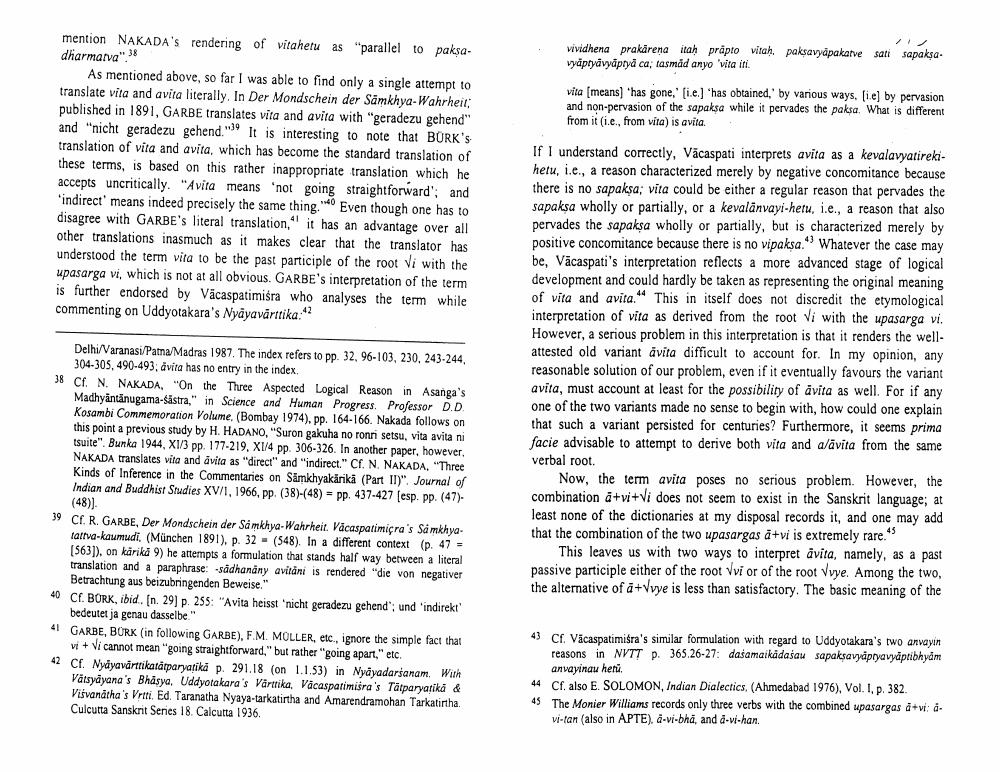Book Title: Avita And Avita Author(s): Eli Franco Publisher: Eli Franco View full book textPage 6
________________ vividhena prakarena itah prapto vitah, paksavyapakatve vyāphyāvāptyä сa, tasmád anyo 'vita iti. sati sapaksa. vita (means) 'has gone,' [ie] 'has obtained.' by various ways, liej by pervasion and non-pervasion of the sapaksa while it pervades the paksa. What is different from it (.e., from vita) is avita." mention NAKADA'S rendering of vitahetu as "parallel to paksadharmarva": 38 As mentioned above, so far I was able to find only a single attempt to translate vita and avita literally. In Der Mondschein der Samkhya-Wahrheit published in 1891, GARBE translates vita and avita with "geradezu gehend" and "nicht geradezu gehend. "39 It is interesting to note that BURK'S translation of vita and avita, which has become the standard translation of these terms, is based on this rather inappropriate translation which he accepts uncritically. "Avita means 'not going straightforward'; and 'indirect' means indeed precisely the same thing." Even though one has to disagree with GARBE's literal translation," it has an advantage over all other translations inasmuch as it makes clear that the translator has understood the term vita to be the past participle of the root Vi with the upasarga vi, which is not at all obvious. GARBE's interpretation of the term is further endorsed by Vacaspatimisra who analyses the term while commenting on Uddyotakara's Nyāyavārttika:"2 Delhi/Varanasi Patna/Madras 1987. The index refers to pp. 32, 96-103, 230, 243-244, 304-305, 490-493, avita has no entry in the index. 38 Cf. N. NAKADA. "On the Three Aspected Logical Reason in Asanga's Madhyäntänugama-sastra," in Science and Human Progress. Professor D.D. Kosambi Commemoration Volume (Bombay 1974), pp. 164-166. Nakada follows on this point a previous study by H. HADANO, "Suron gakuha no ronni setsu, vita avita ni tsuite". Bunka 1944, X1/3 pp. 177-219. X1/4 pp. 306-326. In another paper, however, NAKADA translates vita and avita as "direct" and "indirect." C. N. NAKADA, "Three Kinds of Inference in the Commentaries on Samkhyakärikä (Part II)". Journal of Indian and Buddhist Studies XV/1, 1966, pp. (38)-(48) = pp. 437-427 (esp. pp. (47) (48)). 39 Cf. R. GARBE, Der Mondschein der Samkhya-Wahrheit. Vacasparimiçre's Sa mkhya. tartva-kaumudi. (München 1891), p. 32 - (548). In a different context (p. 47 - [563]), on karika 9) he attempts a formulation that stands half way between a literal translation and a paraphrase: -sadhanány a vitani is rendered "die von negativer Betrachtung aus beizubringenden Beweise." 40 Cf. BORK, ibid., (n. 29) p. 255: "Avita heisst nicht geradezu gehend' und 'indirekt bedeutet ja genau dasselbe." 41 GARBE, BORK (in following GARBE), F.M. MOLLER, etc, ignore the simple fact that v + Vi cannot mean "going straightforward." but rather "going apart," etc. 42 Cf. Nyayavarttikatatparyatika p. 291.18 (on 1.1.53) in Nyayadarsanam. With Vätsyāyana's Bhäsya, Uddyotakara's Värttika. Vācasparimisra's Tätparyatika & Visvanatha's Vrtti. Ed. Taranatha Nyaya-tarkatirtha and Amarendramohan Tarkatirtha. Culcutta Sanskrit Series 18. Calcutta 1936. If I understand correctly, Vācaspati interprets avita as a kevalavyatirekihetu, i.e., a reason characterized merely by negative concomitance because there is no sapaksa; vita could be either a regular reason that pervades the sapaksa wholly or partially, or a kevalanvayi-hetu, i.e., a reason that also pervades the sapaksa wholly or partially, but is characterized merely by positive concomitance because there is no vipaksa." Whatever the case may be, Vacaspati's interpretation reflects a more advanced stage of logical development and could hardly be taken as representing the original meaning of vita and avita." This in itself does not discredit the etymological interpretation of vita as derived from the root Vi with the upasarga vi. However, a serious problem in this interpretation is that it renders the wellattested old variant avita difficult to account for. In my opinion, any reasonable solution of our problem, even if it eventually favours the variant avita, must account at least for the possibility of avita as well. For if any one of the two variants made no sense to begin with, how could one explain that such a variant persisted for centuries? Furthermore, it seems prima facie advisable to attempt to derive both vita and a/āvita from the same verbal root. Now, the term avita poses no serious problem. However, the combination a + vi+Vi does not seem to exist in the Sanskrit language; at least none of the dictionaries at my disposal records it, and one may add that the combination of the two upasargas ä+vi is extremely rare." This leaves us with two ways to interpret avita, namely, as a past passive participle either of the root vvi or of the root Vvye. Among the two, the alternative of a+Vvye is less than satisfactory. The basic meaning of the 43 Cf. Vacaspatimisra's similar formulation with regard to Uddyotakara's two anvayin reasons in NYTT p. 365.26-27: dasama kadašau sapaksavyaptya vyapríbhyam anvayingu hetu. 44 Cf. also E. SOLOMON, Indian Dialectics, (Ahmedabad 1976), Vol. I, p. 382. 45 The Monier Williams records only three verbs with the combined upasargas d+vi: vi-tan (also in APTE). a-vi-bhā, and a-vi-han.Page Navigation
1 ... 4 5 6 7 8
